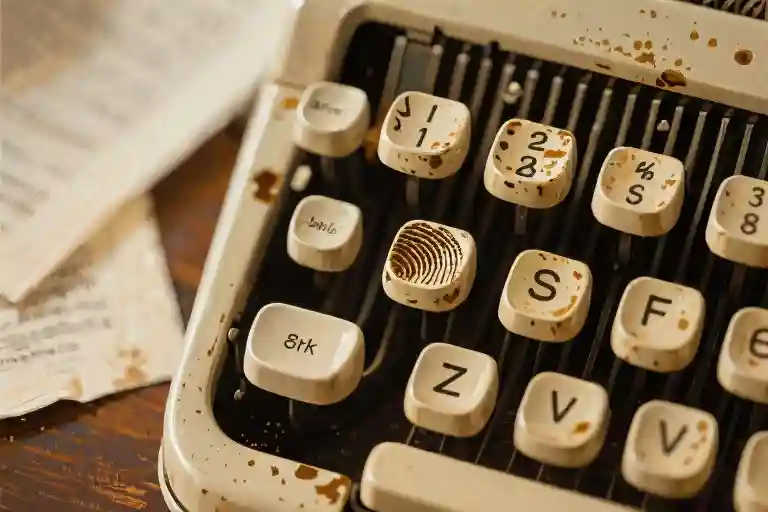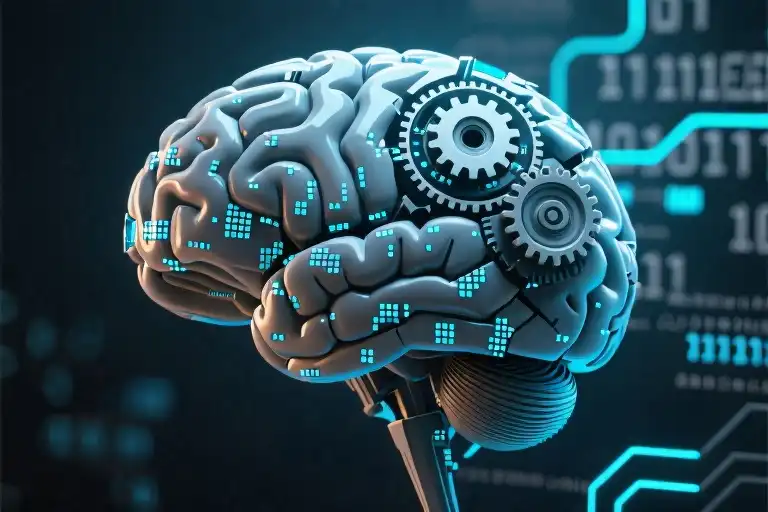The typewriter keys stick slightly on the ‘e’ and ‘n’, requiring just enough pressure to leave fingerprints on the metal. A coffee ring stains the corner of the manuscript where last night’s cup sat forgotten. These marks – the smudges, the hesitations, the crossed-out lines – used to be the fingerprints of literature itself. Now they’re becoming artifacts in an age where perfection arrives with a click.
For centuries, writing meant stained fingers and sleepless nights chasing sentences that shimmered just beyond reach. The work carried its scars proudly: inkblots like battle wounds, crumpled drafts filling wastebaskets, paragraphs rewritten seventeen times before achieving that fragile alchemy we called ‘voice’. The struggle wasn’t incidental – it was the thing that made the words matter. Walter Benjamin called it ‘aura’, that glow of authenticity radiating from art made by human hands wrestling with human limits.
Today’s writing arrives pre-sanitized. No fingerprints. No coffee rings. No evidence of the all-night despair that sometimes births dawn breakthroughs. The algorithm doesn’t sweat over word choices or pace the floor at 3am; it generates flawless prose on demand, adjusting tone like a thermostat. Want a sonnet in Shakespearean style about quantum physics? A noir detective story set on Mars? The machines deliver without complaint, without hesitation, without ever needing to believe in what they’re making.
This shift goes deeper than convenience. When Benjamin wrote about mechanical reproduction in the 1930s, he saw how photography and film were divorcing art from its ‘ritual basis’. A painting’s aura came from its singular existence in time and space – the fact that you had to stand before this particular canvas, seeing brushstrokes left by a hand that once held these exact brushes. Copies could simulate the image, but not the presence.
Now that same uncoupling is happening to language itself. The aura of writing never lived in the words alone, but in their becoming: the visible struggle to carve meaning from silence. An AI-generated novel might perfectly mimic literary style, but it will never include that one sentence the writer kept for purely personal reasons – the line that ‘isn’t working’ but feels too true to delete. The machines don’t have irrational attachments to flawed phrases. They optimize.
Already we’re seeing the first tremors of this transformation. Online platforms fill with algorithmically polished content that reads smoothly and says nothing. Students submit essays written by chatbots with better grammar than their teachers. Publishers quietly use AI to generate genre fiction tailored to market analytics. The texts are technically impeccable, emotionally calibrated, and utterly forgettable – like drinking from a firehose of sparkling water.
Benjamin worried that mechanical reproduction would turn art into politics (who controls the means of production?) and science (how do we measure its effects?). He wasn’t wrong. But he couldn’t have anticipated how the digital age would make words themselves infinitely replicable – not just their physical forms, but their creation. When writing becomes a parameter-adjustment exercise, we’re left with urgent questions: Can literature survive its own frictionless reproduction? And if the struggle was always part of the meaning, what happens when the struggle disappears?
The Algorithmic Reshaping of Writing
There was a time when writing left stains—ink on fingertips, coffee rings on manuscripts, the faint scent of tobacco clinging to crumpled drafts. These traces marked the physical struggle of creation, the hours spent wrestling with words that refused to align. Today, that struggle evaporates with a keystroke. AI writing tools generate flawless prose before our coffee cools, their output as pristine as the blank screens they replace.
The numbers tell a stark story. The AI writing assistant market, valued at $1.2 billion in 2022, is projected to reach $4.5 billion by 2028. Platforms like ChatGPT serve over 100 million users monthly, while niche tools like Sudowrite cater specifically to fiction writers. This isn’t gradual adoption—it’s a linguistic landslide.
Walter Benjamin’s concept of ‘aura’—that ineffable quality of authenticity in art—becomes hauntingly relevant here. In his 1935 essay, he mourned how mechanical reproduction stripped artworks of their unique presence in time and space. What he couldn’t anticipate was how algorithms would democratize that loss, applying it to humanity’s oldest technology: language itself.
Consider two manuscripts:
- A draft of Hemingway’s The Sun Also Rises, archived at the JFK Library, shows entire paragraphs excised with angry pencil strokes. The margins bristle with alternatives—’bullfight’ becomes ‘corrida,’ then ‘blood ritual,’ before circling back. Each revision carries the weight of a man trying to carve truth from memory.
- A contemporary AI-generated novel, produced in 37 seconds via prompt engineering. The text has perfect grammar, consistent pacing, and zero crossings-out. It meets all technical criteria for ‘good writing’ while containing no human hesitation.
The difference isn’t just in process, but in ontological status. Traditional writing was alchemy—transforming lived experience into symbols. Algorithmic writing is transcription—converting parameters into prose. As the Paris Review recently noted: ‘We’re not losing bad writing; we’re losing the evidence of writers becoming good.’
This shift manifests in subtle but profound ways:
- The death of drafts: Earlier versions disappear into the digital void, erasing the archaeological layers of thought
- The illusion of fluency: Perfect first drafts mask the cognitive labor that once made writing a transformative act
- Configurable creativity: Dropdown menus replace discovery (‘Choose your style: Kerouac × Margaret Atwood’)
Yet perhaps the most significant change is psychological. When Walter Benjamin wrote about aura, he focused on the viewer’s experience of art. In the age of algorithmic writing, we must consider the creator’s experience too. That trembling moment before creation—what the French call l’angoisse de la page blanche (the anguish of the blank page)—was never just fear. It was the necessary friction between self and world, the resistance that made writing matter.
As one novelist friend confessed: ‘I miss my terrible first drafts. The AI’s perfect ones feel like wearing someone else’s skin.’ This isn’t nostalgia; it’s the recognition that writing, at its best, was never just about producing text. It was about the irreversible change wrought in the writer during its production.
The algorithms haven’t just changed how we write. They’ve changed what writing means. When every sentence can be conjured effortlessly, we must ask: What happens to the selves we used to build word by painful word?
The Three Possible Futures of Literature in the Algorithmic Age
The ink-stained fingers of writers have barely dried from the last century, yet we already find ourselves standing at the precipice of a new era—one where literature emerges not from the trembling pulse of human solitude, but from the humming servers of cloud computing. The question isn’t whether AI will change writing (it already has), but rather what kind of future this technological shift might bring. Three distinct paths emerge from the fog of possibility, each reshaping our relationship with words in fundamentally different ways.
The Golden Flood: When Words Become Weather
Picture a world where personalized novels generate faster than morning coffee brews. You want a mystery-thriller combining Jane Austen’s wit with Elon Musk’s Twitter feed? The algorithm delivers before you finish your sentence. This is literature as pure configuration—endlessly customizable, instantly forgettable, as ubiquitous and unremarkable as oxygen.
In this scenario, books become like playlist algorithms: they reflect us perfectly while leaving no lasting impression. The ‘golden’ refers not to quality, but to the economic alchemy turning all human experiences into monetizable data points. Writing transforms from discovery into interface design, where the real artistry lies in crafting the perfect prompt rather than wrestling with sentences.
Human authors don’t disappear so much as become irrelevant—like blacksmiths in the age of 3D printing. Some persist as boutique artisans, their manuscripts bearing the prized defects of human limitation: typos, inconsistencies, the occasional flash of inexplicable brilliance. But their work occupies the cultural position of handmade soap—admired, expensive, and fundamentally unnecessary to daily life.
The Literary Zoo: Where Human Writing Goes on Display
Alternatively, imagine museums where people pay to watch authors compose in real time. Sweat beads on brows as fingers hover over analog typewriters. Signs proclaim ‘Certified AI-Free Content’ like organic food labels. Universities offer advanced degrees in ‘Pre-Digital Composition Techniques.’
This future treats human writing like Japanese Noh theater or Renaissance fresco techniques—preserved not for utility but for cultural continuity. The ‘literary zoo’ metaphor cuts both ways: it suggests both conservation and captivity. Readers don’t come for the texts (which machines produce better anyway), but for the ritualistic spectacle of watching Homo sapiens perform their ancient linguistic dances.
Libraries might cordon off ‘Human Writing’ sections with velvet ropes, while algorithmically-generated bestsellers fill the main shelves. The irony? The very qualities that make human writing valuable in this scenario—its inefficiency, its unpredictability—are precisely what made it art in the first place. When uniqueness becomes a selling point rather than a natural consequence of expression, we’ve entered the realm of cultural taxidermy.
The Symbiotic Age: Authors as Meaning-Curators
The most probable future lies somewhere between these extremes—not replacement nor segregation, but evolution. Writers become less like solitary geniuses and more like orchestra conductors, blending human intuition with machine capabilities. A poet might begin with a raw emotional impulse, then use AI to generate twenty formal variations on that feeling before manually reshaping three into something wholly new.
In this hybrid model, authorship transforms from creation to curation. The ‘meaning’ of a text exists in the interplay between human intention and algorithmic suggestion. Writers develop new skills: prompt engineering becomes as crucial as plot structure, style calibration as important as character development. The aura Benjamin mourned doesn’t vanish—it migrates from the physical artifact to the creative process itself.
This future offers exhilarating possibilities (imagine real-time collaborative storytelling across languages) and profound challenges (who ‘owns’ a sentence when both human and machine co-wrote it?). The literary critic of 2050 might analyze texts not for authorial voice but for ‘intention signatures’—those telltale traces revealing where human choices steered algorithmic output.
The Unanswerable Question
All three futures share one uncomfortable truth: they make the writing process more visible than ever before. When every keystroke can be tracked, every influence mapped, every creative decision quantified, something essential retreats into shadow. Perhaps what we risk losing isn’t literature’s body, but its ghost—those ineffable qualities that made us whisper ‘how did they do that?’ before the age of explainable AI.
Yet for all these transformations, one constant remains: the blank page still terrifies. Not the machine’s blank page (which is just unallocated memory), but the human one—that white rectangle staring back, demanding we make marks that matter. No algorithm can replicate that particular species of fear, nor the quiet triumph when we overcome it. However literature evolves, that trembling moment of beginning may prove to be the last irreducible fragment of the writing act.
The Persistence of Slow Writing
There’s a particular kind of silence that settles around a writer struggling with a blank page. It’s not the peaceful quiet of an empty room, but the charged stillness before creation—a space filled with equal parts terror and possibility. This silence, once the natural habitat of all writing, has become an endangered species in the age of algorithmic composition.
What we lose when machines remove the struggle from writing isn’t just the romantic image of the tortured artist—it’s something more fundamental. The resistance that once defined the writing process—the false starts, the crossed-out paragraphs, the moments of staring at the ceiling—wasn’t just suffering. It was the friction that gave writing its moral weight. When every sentence arrives polished and complete with a keystroke, we sacrifice what Walter Benjamin might have called the ‘aura of effort’—that quality that makes human writing feel like a transmission from one mind to another rather than a product assembled from linguistic data.
Consider the physicality of traditional writing—the ink-stained fingers mentioned earlier, the coffee rings on manuscript pages, the way a writer’s posture changes during hours at the desk. These aren’t just sentimental details. They’re traces of time invested, of a mind wrestling with itself. The imperfections in human writing—the awkward phrasing that somehow works, the strange digressions that reveal unexpected truths—are the fingerprints left by this struggle. Machine writing, for all its fluency, lacks these fingerprints. It’s like comparing hand-thrown pottery to mass-produced ceramics—both hold water, but only one carries the marks of its making.
This resistance serves another purpose: it forces writers to confront what they actually mean. The easy flow of AI-generated text skates across the surface of thought, while human writing often stumbles into depth precisely because it stumbles. The hesitation before choosing a word, the frustration of failed sentences—these aren’t obstacles to good writing but part of its alchemy. They’re how writers discover what they didn’t know they wanted to say.
Perhaps the most subversive act in an age of instant text will be the decision to write slowly anyway—not out of nostalgia, but because some truths only emerge through sustained effort. There’s a reason we still value handwritten letters in an era of emails: the time invested becomes part of the message. When writing becomes frictionless, it risks becoming weightless too—easy to produce, easy to forget.
The ‘aura’ Benjamin mourned may not disappear entirely in the algorithmic age, but it will migrate. No longer located in the physical artifact (the manuscript, the marked-up galley proofs), it will reside in the decision to write without technological assistance—in the choice to endure the silence and uncertainty of creation when easier alternatives exist. In this sense, the value of human writing may become less about the product and more about the testimony implicit in its making: I struggled with this. I cared enough to persist.
Readers, consciously or not, respond to this testimony. The relationship between reader and text changes when both know no human hand shaped the words. It’s the difference between a meal prepared by a chef and one assembled by a vending machine—even if the ingredients are identical, the experience isn’t. This doesn’t make machine writing worthless (vending machines serve a purpose), but it does make human writing different in kind, not just quality.
What emerges isn’t a simple hierarchy of value, but a new ecology of writing. Machine-generated text will excel at providing information, generating variations, meeting immediate needs. Human writing will become what it perhaps always was at its best: a record of attention, a map of a particular mind at work. The two can coexist, even complement each other, so long as we remember why we might still choose the slower path.
That choice—to write despite the availability of easier options—may become the new ‘aura’ of literature. Not because it’s noble or old-fashioned, but because it preserves something essential: writing as an act of discovery rather than production, a process that changes the writer as much as it communicates to readers. The handwritten paragraph in a world of auto-generated text isn’t a relic—it’s a rebellion.
The Hand-Forged Paragraph
There’s something quietly rebellious about writing by hand in an age of algorithmic abundance. Not because it’s better, or purer, or more virtuous – but because it’s stubbornly inefficient. Like keeping a sundial when atomic clocks exist. Like whittling wood when you could 3D print. Like forging nails by hand when machines produce them by the millions.
At the start of the twentieth century, most nails were already machine-made. Yet some still chose to heat the iron, hammer the shape, and feel the metal yield beneath their hands. Not because these handmade nails held doors together more securely, but because the act itself meant something. The irregular grooves told a story no perfect factory product could replicate.
So it is with writing now. In a world where flawless paragraphs generate at the tap of a key, where entire novels assemble themselves based on our reading history, where style transfer algorithms can mimic any author dead or alive – why would anyone still write the slow way? Why endure the blank page’s terror, the false starts, the crossed-out lines, the hours spent chasing a single stubborn sentence?
Because the value no longer lives in the product, but in the process. Because the ‘aura’ Walter Benjamin mourned hasn’t disappeared – it’s simply migrated from the published work to the act of creation itself. The hesitation before committing words to paper. The coffee stain on the third draft. The way a paragraph shifts shape between morning and evening. These aren’t imperfections to be optimized away, but evidence of a human presence no algorithm can counterfeit.
This isn’t about rejecting technology. The same industrial revolution that made machine-cut nails also gave us steel bridges and skyscrapers. AI writing tools will undoubtedly unlock new creative possibilities we can’t yet imagine. But progress doesn’t require complete surrender – there’s room for both the hydraulic press and the blacksmith’s forge.
Perhaps future literature will bifurcate, like food culture after the microwave’s invention. Most will consume the algorithmic equivalent of instant meals – convenient, predictable, nutritionally adequate. A minority will still seek out slow-crafted writing, not because it’s objectively superior, but because it carries the marks of its making. The literary equivalent of sourdough bread with its irregular holes, or hand-thrown pottery with its slight wobbles.
The resistance isn’t against machines, but against the assumption that efficiency is the sole metric of value. When every sentence comes pre-polished, we lose something vital – the friction that forces us to clarify our thoughts, the struggle that makes certain phrases worth remembering. There’s gravity in effort. There’s meaning in the choices we preserve despite easier alternatives.
So write your clumsy first drafts. Fill notebooks no one will read. Cross out more than you keep. Do it not for an audience, but for the private satisfaction of wrestling meaning from chaos. In an age of infinite artificial fluency, the most radical act might be to embrace limitation – to write slowly, imperfectly, and entirely for yourself.
Because no matter how eloquent the machines become, they’ll never know the quiet triumph of a paragraph forged by hand.





